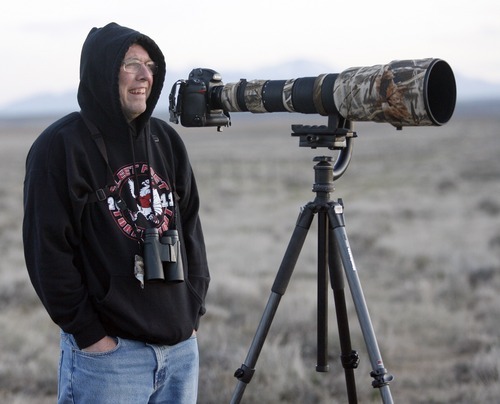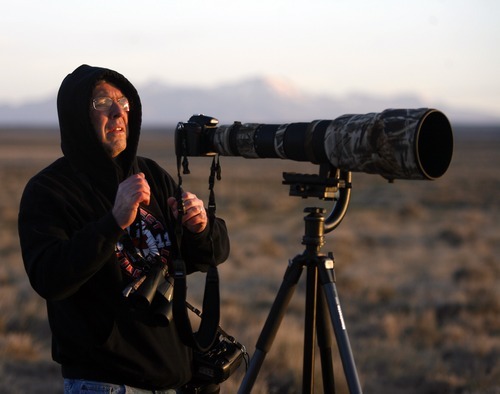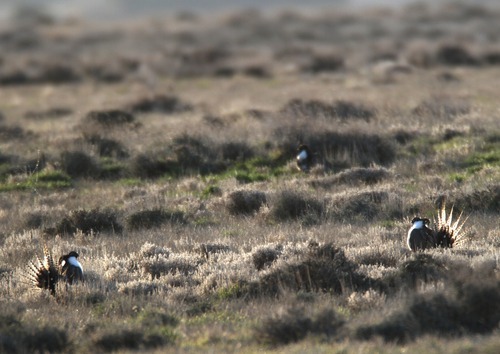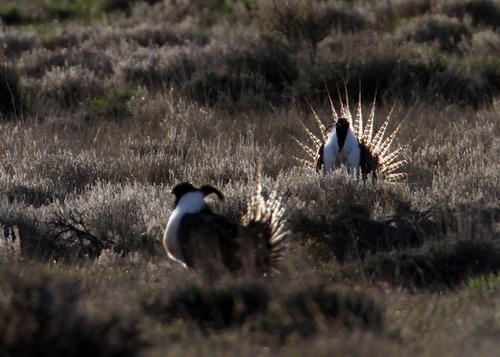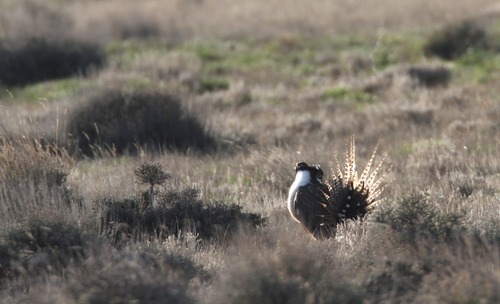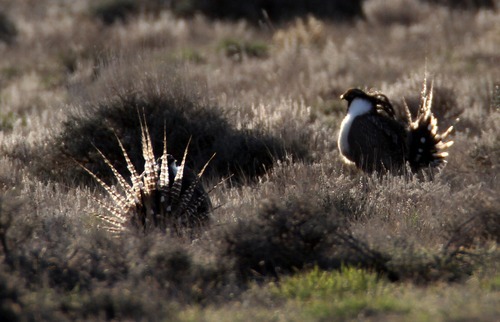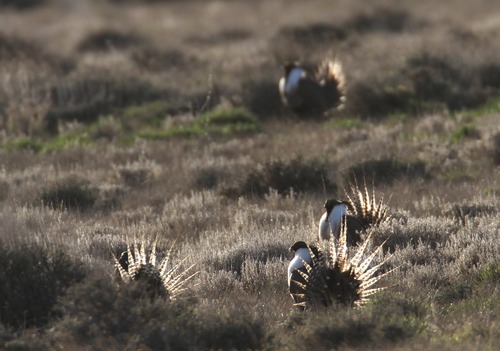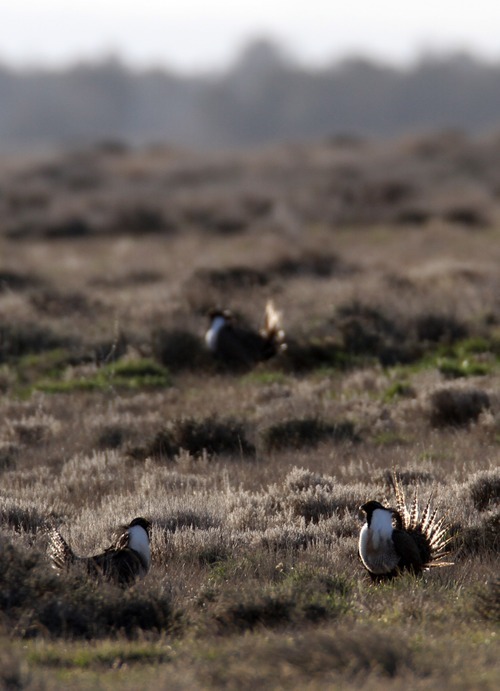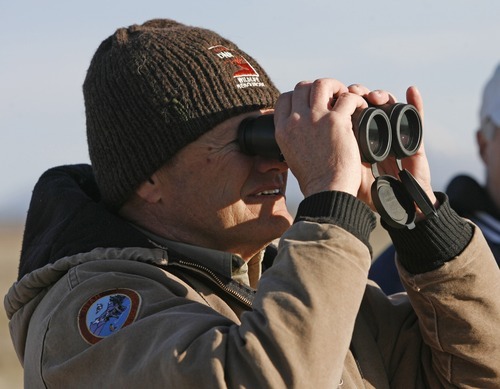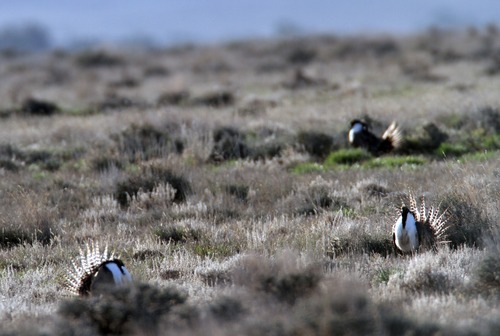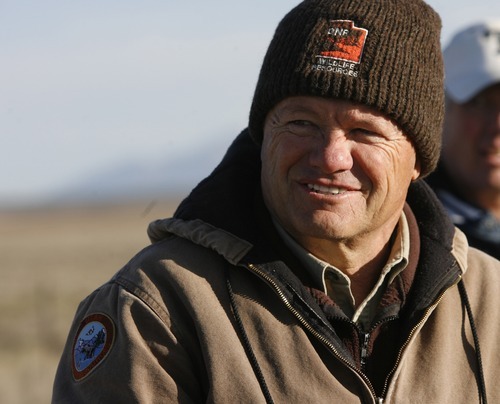This is an archived article that was published on sltrib.com in 2012, and information in the article may be outdated. It is provided only for personal research purposes and may not be reprinted.
Monticello • Utah's other sage grouse is dancing on the edge.
Smaller and — if it's possible — funkier than the wide-ranging greater sage grouse, the Gunnison sage grouse lives only in western Colorado and here in a flat, purple scrubland pocket of southeastern Utah.
By all accounts, it will be proposed for protection under the Endangered Species Act by fall with a year of rule writing to follow before the U.S. Fish and Wildlife Service makes a final decision on the grouse's status.
The 5-pound black and brown birds with gleaming white chests, oblivious to the regulatory buzz, are a sight to behold. A dozen cocks dance in the chilled late-March dawn, on the same sagebrush opening that they visit every spring to compete for hens.
They strut past one another, occasionally facing off for a stare-down that ends violently: both pairs of wings thrust skyward and simultaneously hacked down karate-style on the rival's shoulders. It ensures personal space — and sometimes kills by breaking the neck.
In his own space and in a zone, each cock jets air into two bare breast balloons that gurgle and plop in the tones of a slow-boiling mud pot. The head jerks forward and a black tassel that's thicker and longer than the lacy crown on a greater sage grouse whips the air like a heavy-metal head-banger's mullet.
"These are absolutely fun," birder Rich Vial says while reeling off thousands of photos and some video during a small viewing tour with the Utah Division of Wildlife Resources. Vial flew to Salt Lake City from Portland, Ore., then drove five hours to be here and cross Bird No. 475 off his North American species-viewing list. "Very different, in terms of the display, from greater sage grouse."
Squinting through the viewfinder, he chuckles. "It's that headpiece they throw. Why would they do that? I don't know."
One male will dominate, breeding 80 percent or more of the hens. Biologists think something in the look and sound of his puffery says robust health, and that a faint fiddling of his wing suggests a bug-free groom; we can't really know what the hens are thinking. They hang around the edge and scarcely show themselves.
The birders can't get enough, but the birds will give them only an hour or so. With full daylight, the eagles fly. Grouse need to take cover under the sagebrush.
There are 4,100 Gunnison sage grouse left, federal biologists estimate, and only 100 of them in Utah. There were 200 until two winters ago, when a brutal snow year blanketed the sagebrush and left the birds little food and nowhere to hide.
These birds already are classified endangered by the International Union for Conservation of Nature's global "Red List." And, if they're endangered worldwide, University of Utah ornithologist Cagan Sekercioglu says, it follows that the United States would list them, too.
"Of course you have to work with the local people, and you don't want to upset them," Sekercioglu says. "The U.S. Endangered Species Act may be the best law in the world for protecting species."
The state, from Gov. Gary Herbert down, doesn't want to go there. Neither does Guy Wallace, the regional Division of Wildlife Resources biologist for this corner of the state.
Most grouse here are on private farms, he says. Many landowners have set aside grasses and shrubs for the birds in exchange for either conservation easements that the state bought or yearly contracts with the U.S. Department of Agriculture.
"I don't know what kind of reaction [to a listing] we'll get from landowners," Wallace says. "We would prefer to maintain jurisdiction on the ground."
Federal protection for these birds won't have nearly the same economic consequences as such status would for greater sage grouse — given the small speck on Utah's map where they live. But try telling that to Bruce Adams, the rancher whose land contains this breeding ground.
Adams, who also heads the San Juan County Commission, sold the state a conservation easement across a couple of thousand acres to save the bird. He doesn't trust federal biologists to safeguard property rights.
"I've done everything I can to try and help them keep the Gunnison sage grouse from getting listed," he says. "We'd much rather deal with the state."
bloomis@sltrib.com Blame the raven?
Ravens are gaining habitat as humans change the West's landscape to their liking, and ravens are also voracious raiders of sage grouse nests. Those who fear federal restrictions on economic activities — and especially ranchers who watch the ravens steal eggs — frequently argue that killing or discouraging ravens is the key.
"People out there just tell me that if we could just take care of the predators, we would end the [grouse] deaths," Uintah County Commissioner Mike McKee said this month at a meeting of the state's grouse working group.
"That's that hope for a silver bullet," group leader Bob Budd responded, cautioning that it takes a complicated mix of efforts to save the sage grouse.
Federal officials do poison eggs to kill ravens in some places. But they don't believe reducing ravens is as crucial to the grouse as preserving sagebrush habitat.


